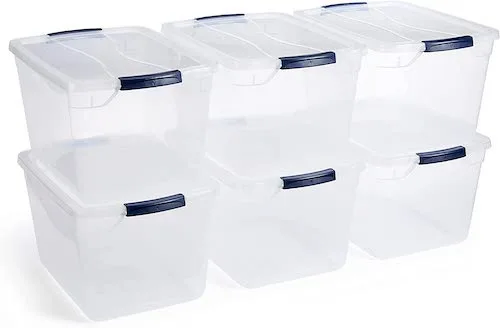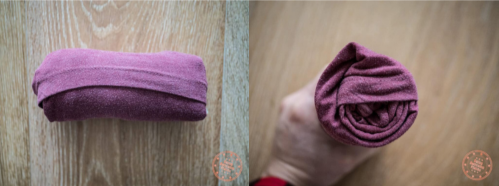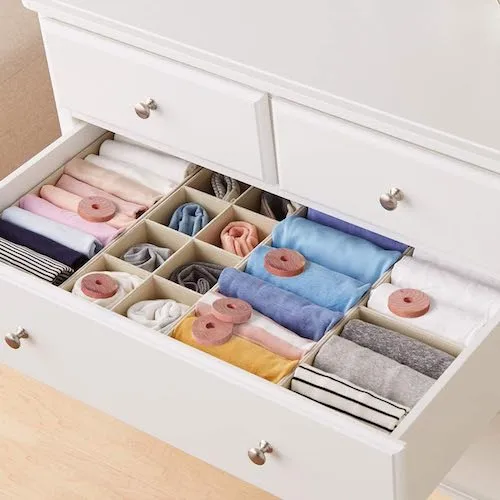Jump to Section
- Sorting and organizing off-season clothing
- Clean and dry seasonal clothing before storing
- What are the best clothing storage bins for seasonal clothing?
- How to pack clothes for storage
- Storing off-season clothes
- Check on your stored seasonal clothing
- Additional tips for storing clothing
Storing off-season clothes properly is a game changer. Not only does it free up space in your closet for the clothes you and your family actually wear, but it helps preserve them, maximizing the bang for your buck by preventing color fading, mold and insect damage. Here are some top tips and expert advice that will teach you how to store off season clothes like a pro.
Sorting and Organizing Off-Season Clothing
In order to get where you’re going, you have to figure out where you are right now by doing some sorting and organizing. Start by categorizing your clothing by season. Spring/summer, fall/winter: you know the drill. This step is crucial to figuring out what you have, what needs to be replaced, and what needs to go into hibernation.
This is also the perfect opportunity to do some weeding. Put on a personal fashion show, and gauge the fit, style and extent of wear of each article of clothing. Consider donating those that still have value, but no longer suit your needs. One person’s fashion faux pas may be another’s new OOTD!

Clean and Dry Seasonal Clothing Before Storing
The next step is an obvious, but crucial, step for storing clothing: before you pack anything away, make sure they’re as clean as possible and bone-dry. Elizabeth Grace, the designer and home expert behind Dream Home Making, spells it out clearly. “Before storing any garments, ensure they are clean and free of stains. Dirt or stains left on clothes become more difficult to remove over time,” she said.
Do right by future you by giving those clothes a good wash and dry, taking care to remove any stubborn stains and funky odors beforehand. Keep in mind that clothing that hasn’t been sufficiently dried is a recipe for mold, mildew, and pests.
This is also the perfect moment to mend and repair. Grace says, “Check your clothes for any loose buttons and threads, or small tears. Repairing these minor issues before storing them will prevent further damage and make the garments ready to wear when the season comes back around.”

What Are the Best Clothing Storage Bins for Seasonal Clothing?
Before we get to the process, let’s find the right materials for the job. When it comes to storage containers for clothing, sturdy and stackable plastic bins are a popular choice that easily keep out dust and pests.
“They offer superior protection to cardboard boxes, which can deteriorate over time, are more challenging to maneuver, and can be infiltrated by rodents and insects,” suggests Olivia Parks of Professional Organizer New Orleans.

If space or funds are limited, suitcases, canvas bags, metal z-racks, hanging garment bags and vacuum-sealed bags can get the job done, too!
How to Pack Clothes for Storage
When it comes to packing your clothes for storage, proper technique is all about minimizing creasing and wrinkles, and ensuring that there is sufficient air circulation throughout the items by resisting the temptation to cram it all in. Parks cautions that while clear plastic bins make a great storage container, overpacked bins can prevent air flow, and encourage mold growth and deterioration of natural fibers.
Since they’ll be tucked away for months, you’ll have to consider what works best for each garment. Rolling T-shirts, rather than folding them, is a great space-saving technique that keeps the goods mostly wrinkle free. Delicate items may require extra TLC. Putting tissue paper between the folds of sweaters and knits, and hanging dresses, coats and jackets on sturdy hangers inside protective, breathable garment bags may be your best bet to protect delicate fabrics and bulky, structured items.

For easy access, create a simple inventory system, numbering your storage containers and keeping a detailed list of their contents. This will help you find what you need or want in a pinch. Alternatively, you can create general labels so that you can quickly grab the bins and items based on season or family member.
Storing Off-Season Clothes
It’s time to find a cozy spot for your clothing organizer bins to call home. This will all come down to your living situation. If you’re blessed with a spacious closet or wardrobe, lucky you! That’s the ideal spot if you want to maximize accessibility.
But if you’re tight on space, you might have to get creative. Soxy.com’s resident fashion designer, Jessica Kats, suggests extra room cabinets or laundry areas as suitable options. Under the bed or climate controlled storage facilities can be good space-saving alternatives. “It is important to keep in mind the moisture level of the room you choose; otherwise, you can end up damaging the microfibers of your clothing,” she explains. Avoid direct sunlight to prevent color fading, too.
Since you’ll want to limit exposure to moisture, humidity, extreme temperatures, and pests, you should use the garage, attic, or basement as a last resort.
Check On Your Stored Seasonal Clothing
Periodically checking in on your stored clothing is something you’ll want to put on your calendar, especially if they’ll be in long-term storage or a less-than-ideal location. Every six months or so, give your stored clothes a little attention, inspecting for any signs of damage, pests, or moisture. If you notice any issues, take immediate action to prevent further damage. It’s better to catch a problem early on than to create a full-blown clothing catastrophe.
Additional Tips For Storing Clothing
Here are a couple more tips that will take your clothing storage game from good to fabulous.
Nobody wants their clothes to become a buffet for moths, or smell musty and stale. Parks suggests using cedar blocks for natural pest protection. These will deter moths, silverfish, and carpet beetles without the harsh chemicals and off-putting smell of mothballs. Lavender sachets or artisanal lavender wands are a time-honored method of repelling insects and infusing your clothes with a fresh, floral scent.

Have some garments that deserve VIP treatment? If you’re storing a wedding dress, valuable vintage pieces or a luxe winter coat, consider investing in acid-free tissue paper or archival garment bags. These help preserve the fabric and protect against discoloration and deterioration.
Congratulations, my stylish friend! You’ve mastered the art of how to store off season clothes like a pro. By following this straightforward advice, you’ll preserve your investment, maintain the quality of your clothes, and embrace the joy of a well-organized wardrobe, complete with a streamlined, stress-free seasonal rotation.





